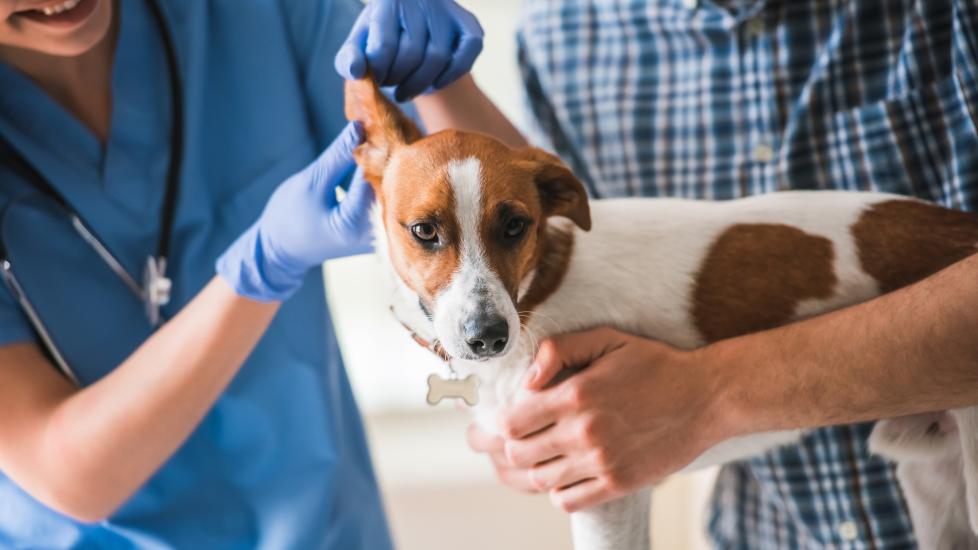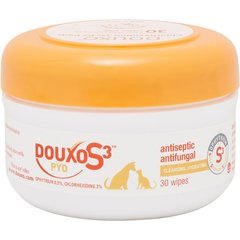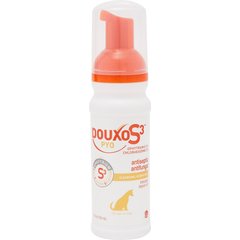Hyperpigmentation in Dogs
What Is Hyperpigmentation in Dogs?
Hyperpigmentation is a darkening and thickening of a dog’s skin. It typically appears as black spots, splotches, or patches.
Hyperpigmentation is not a disease, but a reaction that commonly occurs in addition to chronic inflammation associated with an underlying medical condition.
If you notice any change in the color or texture of your dog’s skin, have them examined by their veterinarian to determine the underlying cause.
While hyperpigmentation is not an emergency, it’s important to ensure the medical condition causing the hyperpigmentation is treated properly. This will prevent further damage to a dog’s skin.
Symptoms of Hyperpigmentation in Dogs
The two main signs of hyperpigmentation are discoloration and thickening of a dog’s skin.
Hyperpigmentation can occur as pinprick-sized areas of rough, light brown or black skin, and can grow to be quite large.
Areas of hyperpigmentation are often hairless and commonly occur on a dog’s legs, armpits, or groin.
These dark areas may be surrounded by red skin if there is an associated skin infection. Over time, hyperpigmentation can spread to the lower neck, abdomen, ankles, rear end, eyes, or ears, and is often the result of itching or friction associated with the underlying cause.
Hyperpigmentation may progress to more severe skin issues—such as extensive hair loss, a secondary infection, or oozing skin—if the underlying cause is not identified and treated.
Causes of Hyperpigmentation in Dogs
Primary hyperpigmentation, which is not caused by an underlying medical condition, is rare and breed-specific, thought to occur only in Dachshunds. Signs typically develop before pups are a year old.
Secondary hyperpigmentation is caused by inflammation or friction against the skin. Secondary hyperpigmentation can occur in any dog breed, although breeds that are predisposed to certain underlying conditions are more susceptible.
Common causes of hyperpigmentation include:
-
Obesity, commonly seen in breeds including:
-
Labrador Retrievers, Pugs, Dachshunds, English Bulldogs, Cairn Terriers, Beagles, Cocker Spaniels, Rottweilers
-
-
Hormonal abnormalities
-
Hypothyroidism, most often seen in the following breeds:
-
Golden Retrievers, Doberman Pinschers, Dachshunds, Miniature Schnauzer, Cocker Spaniels, Irish Setters
-
-
Cushing's disease, commonly seen in breeds including:
-
-
Allergies, most often seen in the following breeds:
-
Labrador Retrievers, German Shepherds, Basset Hounds, Jack Russell Terriers, Lhasa Apsos, Irish Setters, Yorkshire Terriers
-
-
Contact dermatitis, commonly seen in breeds including:
-
Border Collies, German Shepherds, Dalmatians, Doberman Pinschers, Great Danes, Labrador Retrievers, Golden Retrievers
-
-
Skin infections (bacteria, yeast), most often seen in the following breeds:
-
Cocker Spaniels, Standard Poodles, Shar-Peis, American Bulldogs, Doberman Pinschers, English Bulldogs, Labrador Retrievers, American Pitbull Terriers
-
-
Systemic lupus erythematosus (lupus), commonly seen in breeds including:
-
Afghan Hounds, Beagles, Collies, German Shepherds, Irish Setters, Nova Scotia Duck Tolling Retrievers, Old English Sheepdogs, Standard Poodles, Shetland Sheepdogs
-
-
Demodicosis (parasitic skin mites), most often seen in the following breeds:
-
Juvenile onset (young dogs)—English Bulldogs, Staffordshire Bull Terriers, Shar-Peis, Dogue de Bordeaux, Pugs, French Bulldogs, Boxers.
-
Adult onset—Shar-Peis, Shih-Tzus, West Highland White Terriers, Boxers, Border Terriers.
-
How Veterinarians Diagnose Hyperpigmentation in Dogs
A diagnosis of hyperpigmentation is usually made when a vet looks at the characteristic dark skin lesions. If primary hyperpigmentation is suspected, all other causes must first be ruled out first.
To determine the underlying cause of secondary hyperpigmentation, your veterinarian will take a thorough medical history of your pup and perform a physical exam. Skin impression smears (a collection of material from the surface of the skin for analysis) and scrapings (collection of material from deeper in the skin) are performed to test for bacterial, yeast, or mite infections.
A skin biopsy may be needed if your dog has signs of lupus.
Blood and urine testing may also be performed to screen for hormonal conditions such as hypothyroidism. If Cushing's disease is suspected based on blood work and exam results, specialized blood testing and an abdominal ultrasound may be performed to assess the adrenal glands, which secrete substances such as stress hormones.
If allergies are suspected, a thorough dermatology work-up including skin testing, cultures, a hypoallergenic food trial, and dermal skin testing may be needed.
Treatment of Hyperpigmentation in Dogs
Treatment for secondary hyperpigmentation is based on the underlying cause. For example, thyroid supplements can be given for hypothyroidism and oral medications can be given for Cushing's disease.
If your dog's hyperpigmentation is due to obesity, a weight loss plan including a special diet and exercise may be instituted.
If your dog's signs are more severe, injectable and prescription medications—such as allergy medication, steroids, and immune-changing drugs—may be necessary.
If a skin infection is present, the infection is often treated with oral medications (such as antibiotics, antifungals) before the underlying cause can be fully determined and treated.
If skin inflammation is in its early stages, topical treatments—such as medicated shampoos, steroid ointments, and anti-itch creams, sprays, wipes, or mousse—may be helpful.
Medicated shampoos can be used two to three times per week and are most effective if the lather stays on a pup’s skin at least 10 minutes before it is rinsed off. Between baths, other topical treatments can be used to soothe the skin and keep it clean and dry.
There is not an easy fix for most cases and treatment requires time and patience.
Unfortunately, there is no cure for primary hyperpigmentation in Dachshunds; however, treating the symptoms can help your dog feel more comfortable.
Recovery and Management of Hyperpigmentation in Dogs
Most causes of hyperpigmentation in dogs will cause them to have relapses over time.
Frequent veterinary visits and following all instructions—including giving all medications and topical treatments exactly as prescribed—are key in managing your dog’s symptoms.
It can take weeks to months for your dog's skin to return to normal. However, in some cases, a dog’s affected skin does not return to its normal color.
Prevention of Hyperpigmentation in Dogs
Unfortunately, most causes of hyperpigmentation in dogs are not preventable.
Obesity can be prevented by feeding your dog well-balanced, portioned meals, limiting treats, and providing routine exercise.
Hyperpigmentation in Dogs: FAQs
When should I be concerned about my dog’s hyperpigmentation?
Hyperpigmentation should always be a cause for concern—make a vet appointment to determine whether there is an underlying medical problem.
Some causes of hyperpigmentation are easily treated, while others need constant care and routine veterinary check-ups.
Is hyperpigmentation in dogs dangerous?
Fortunately, most causes of hyperpigmentation in dogs are not dangerous and the diagnosis does not typically impact your dog's lifespan or happiness.
How can I treat hyperpigmentation in dogs at home?
Depending on the underlying cause of your dog’s hyperpigmentation, you may be able to treat them at home. However, the initial diagnosis will require a veterinary visit. Speak with your vet about treatment options at home.
Featured Image: vadimguzhva/iStock / Getty Images Plus




